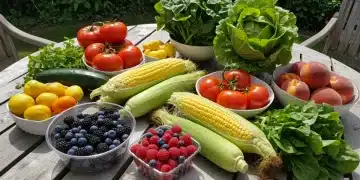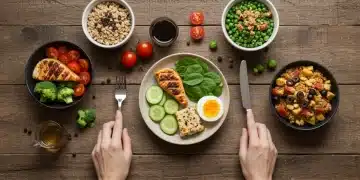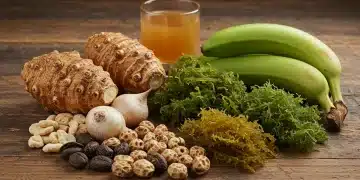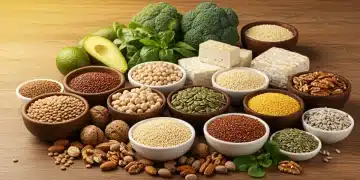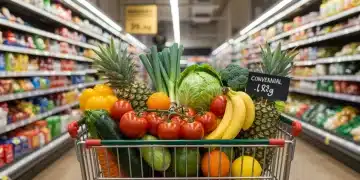Fall 2025 Harvest: Maximize Nutrition with Seasonal Vegetables
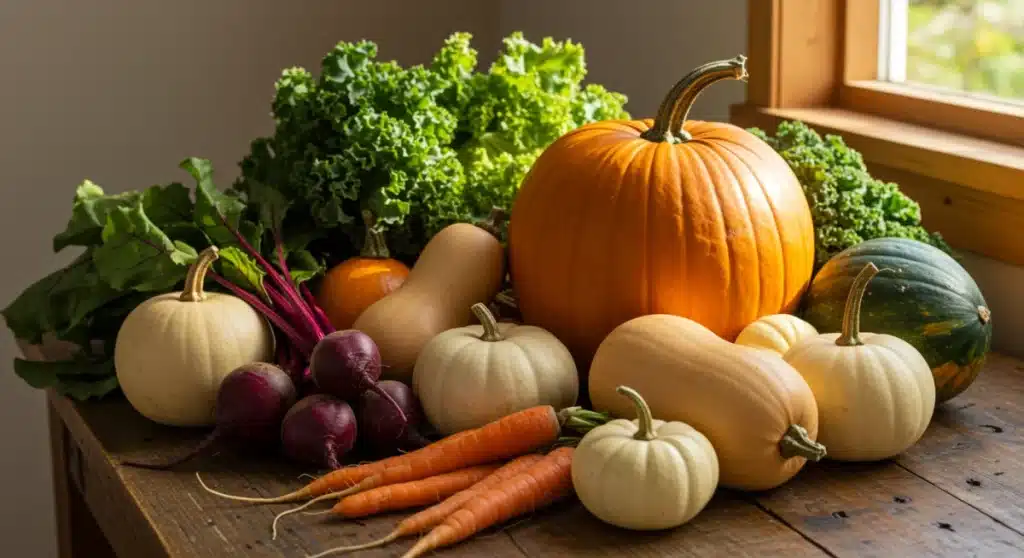
The 2025 fall harvest presents a prime opportunity to enhance your diet with nutrient-rich seasonal vegetables, offering peak flavor and health benefits that support overall well-being and culinary creativity.
As the leaves begin to turn and the air grows crisp, the fall 2025 harvest brings with it an abundance of nature’s finest produce. This time-sensitive opportunity allows us to reconnect with seasonal eating, offering vegetables at their peak flavor and nutritional value. Embracing these gifts from the earth can transform your diet, providing essential vitamins, minerals, and antioxidants to fuel your body through the colder months.
Understanding the Fall 2025 Harvest Cycle
The fall harvest is a pivotal moment for fresh produce availability, marking the culmination of months of growth for many hardy vegetables. Understanding this cycle helps consumers make informed choices, ensuring they select the freshest, most nutrient-dense options. This period typically spans from late August through November, varying slightly by region and specific crop.
During this time, vegetables like squash, root vegetables, and cruciferous greens reach their optimal maturity. Their extended growing season allows them to develop deeper flavors and higher concentrations of beneficial compounds. This natural rhythm of agriculture provides a built-in guide for healthy eating, encouraging diversity in our diets and supporting local farming communities.
Key Fall Vegetables to Look For
Identifying which vegetables are truly in season can sometimes be a challenge amidst year-round supermarket availability. However, a few staples consistently shine during the fall months.
- Squash Varieties: Butternut, acorn, spaghetti, and pumpkin are rich in vitamins A and C, and fiber.
- Root Vegetables: Carrots, beets, parsnips, and sweet potatoes offer complex carbohydrates, essential minerals, and powerful antioxidants.
- Leafy Greens: Kale, collard greens, and Swiss chard are packed with vitamins K, A, and C, along with vital minerals.
- Cruciferous Vegetables: Broccoli, cauliflower, and Brussels sprouts provide significant amounts of vitamin C, fiber, and potent anti-cancer compounds.
By focusing on these varieties, you can ensure your shopping basket is filled with produce that is not only fresh but also at its nutritional peak, offering a superior taste experience compared to out-of-season alternatives. Embracing the fall harvest means embracing a diet that is both delicious and deeply nourishing.
Nutritional Powerhouses of the Season
The vegetables available during the fall 2025 harvest are not just flavorful; they are nutritional powerhouses, each offering a unique profile of health-boosting compounds. Incorporating a diverse range of these seasonal gems into your diet can significantly enhance your overall health and well-being. Their vibrant colors often signal the presence of various phytonutrients, which are plant-based compounds with protective and disease-fighting properties.
Many fall vegetables are particularly rich in vitamins crucial for immune function, a vital aspect as we head into colder months. For instance, the high vitamin C content in Brussels sprouts and kale can help ward off seasonal illnesses, while vitamin A in squash and sweet potatoes supports vision and skin health. Beyond vitamins, the fiber content in these vegetables aids digestion and promotes gut health, which is increasingly recognized as central to overall wellness.
Antioxidant-Rich Options
Antioxidants are compounds that protect your cells from damage caused by free radicals, contributing to anti-aging and disease prevention. Fall vegetables are brimming with them.
- Beets: Contain betalains, powerful antioxidants that give them their deep red color.
- Purple Cabbage: Rich in anthocyanins, which are also found in berries and offer anti-inflammatory benefits.
- Pumpkin: A fantastic source of beta-carotene, which the body converts into vitamin A, acting as a potent antioxidant.
These vegetables not only taste great but also provide a robust defense against cellular damage, supporting long-term health. Making them a regular part of your meals is an investment in your future well-being.
The natural sweetness and earthy flavors of fall vegetables also make them versatile for various culinary applications, from roasting and soups to salads and stews. Their inherent qualities allow for simple preparations that highlight their natural goodness without needing excessive seasoning or unhealthy additions. Prioritizing these seasonal choices means choosing optimal health and deliciousness.
Creative Culinary Uses for Fall Vegetables
Beyond their nutritional benefits, the vegetables of the fall 2025 harvest offer an exciting array of culinary possibilities. Their robust flavors and textures lend themselves well to a variety of cooking methods, encouraging creativity in the kitchen. Moving beyond traditional preparations can unlock new taste experiences and make healthy eating more enjoyable and sustainable.
Think about how the earthy sweetness of a roasted parsnip can elevate a simple soup, or how the slight bitterness of kale can be balanced with a touch of acidity in a salad. The versatility of these vegetables means you can incorporate them into almost any meal, from breakfast to dinner, and even snacks. Experimenting with different cooking techniques, such as roasting, grilling, steaming, or sautéing, can dramatically change their flavor profile and texture, keeping your meals interesting.
Innovative Recipes to Try
Don’t be afraid to step outside your comfort zone with fall vegetables. Here are some ideas to get you started:
- Butternut Squash Risotto: Creamy and comforting, blending the sweetness of squash with savory Parmesan.
- Roasted Brussels Sprouts with Balsamic Glaze: A simple yet elegant side dish that transforms these mini cabbages.
- Sweet Potato and Black Bean Burgers: A hearty vegetarian option packed with flavor and fiber.
- Kale and Apple Salad with Maple Vinaigrette: A refreshing salad that combines sweet, tart, and savory notes.
These dishes not only highlight the best of fall produce but also offer balanced nutrition. They demonstrate that healthy eating doesn’t mean sacrificing flavor or excitement. By exploring new recipes, you can keep your diet varied and prevent mealtime boredom, making it easier to stick to your healthy eating goals.
The culinary journey through the fall harvest is an adventure in itself, inviting you to discover new flavors and techniques. From comforting casseroles to vibrant salads, the possibilities are endless. Embrace the opportunity to cook with these seasonal ingredients and transform your meals into nourishing, delicious experiences.
Maximizing Nutrient Retention in Cooking
While the fall 2025 harvest provides vegetables at their nutritional peak, how we prepare and cook them plays a significant role in retaining those valuable nutrients. Certain cooking methods can diminish vitamin and mineral content, while others help preserve them. Understanding these nuances allows us to make choices that maximize the health benefits of our seasonal produce.
Water-soluble vitamins, such as vitamin C and B vitamins, are particularly susceptible to being leached into cooking water or degraded by high heat. Therefore, methods that minimize contact with water or reduce cooking times are generally preferable. Fat-soluble vitamins, like A, D, E, and K, are more stable but still benefit from careful preparation. The goal is to cook vegetables just enough to make them palatable and digestible while retaining their structural integrity and nutrient density.
Best Cooking Practices
Consider these methods to get the most out of your fall vegetables:
- Steaming: A gentle method that cooks vegetables quickly without submerging them in water, preserving water-soluble vitamins.
- Roasting/Baking: High heat caramelizes natural sugars, enhancing flavor, and minimal water loss helps retain nutrients.
- Sautéing: Quick cooking with a small amount of healthy fat can help absorb fat-soluble vitamins.
- Stir-Frying: Similar to sautéing, this method uses high heat and short cooking times to maintain crispness and nutrients.
Even incorporating raw options, such as shredded carrots or thinly sliced beets in salads, is an excellent way to ensure maximum nutrient intake. Cooking methods that use minimal water or fat, or those that involve quick heating, are generally superior for preserving the nutritional integrity of your fall harvest vegetables. Prioritizing these techniques ensures that every bite is packed with beneficial compounds.
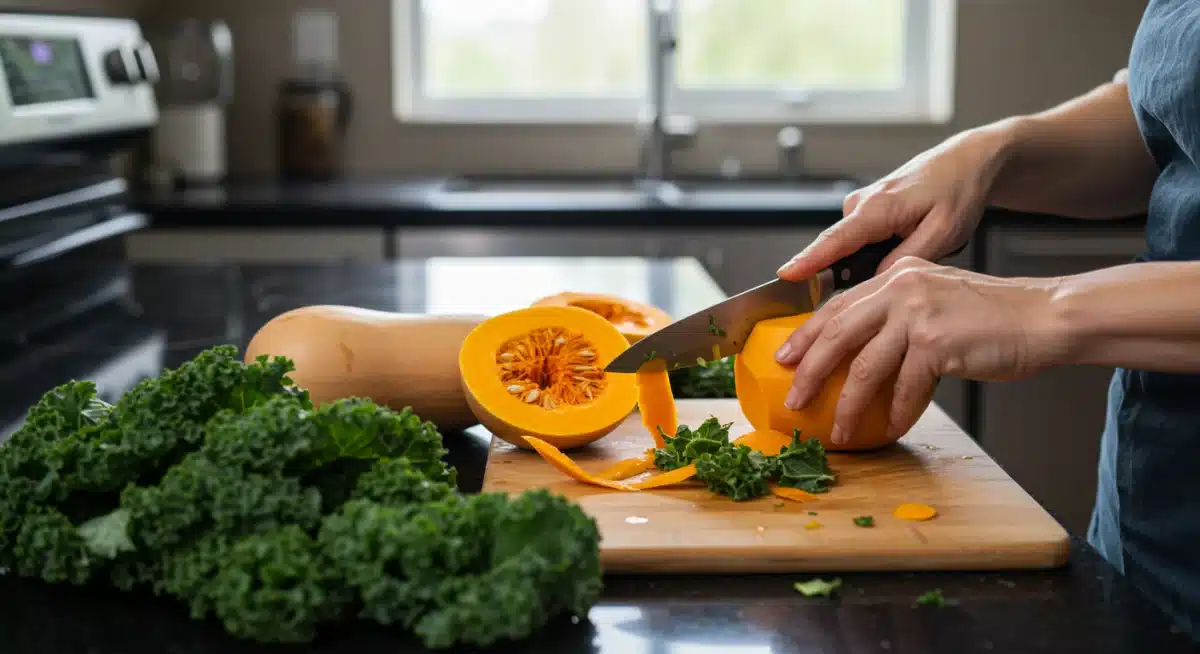
Integrating Fall Vegetables into Everyday Meals
Making seasonal eating a consistent part of your routine doesn’t have to be complicated. The beauty of the fall 2025 harvest lies in the versatility of its produce, allowing for seamless integration into a wide array of everyday meals. From breakfast to dinner, there are countless opportunities to boost your nutritional intake with these fresh, flavorful vegetables.
Starting your day with vegetables might seem unconventional, but it’s a fantastic way to increase your daily intake. Think about adding sautéed spinach or kale to your eggs, or blending pumpkin puree into your morning smoothie. For lunch, hearty salads filled with roasted root vegetables, or a warm vegetable soup, can be both satisfying and nutritious. The key is to think creatively and challenge traditional meal boundaries.
Meal Planning Strategies
Effective meal planning is crucial for successful integration. Here’s how you can do it:
- Batch Cooking: Roast a large tray of mixed fall vegetables at the beginning of the week to easily add to various meals.
- One-Pan Meals: Combine proteins and chopped fall vegetables on a single baking sheet for a simple, nutritious dinner.
- Soup and Stew Bases: Prepare large batches of vegetable broth or soup bases using seasonal ingredients, then freeze portions for quick meals.
By planning ahead and utilizing efficient cooking methods, you can ensure a consistent supply of healthy fall vegetables throughout the week. This approach not only saves time but also reduces food waste and can save money.
Don’t forget about snacks! Roasted chickpeas with a sprinkle of paprika and cumin, or baked sweet potato fries, offer healthy alternatives to processed snacks. The ease with which fall vegetables can be incorporated into every meal makes them indispensable for a balanced and healthy diet. Embrace the season and let your culinary imagination flourish.
Sourcing and Sustainability of Fall Produce
Beyond personal nutrition, embracing the fall 2025 harvest has significant implications for environmental sustainability and local economies. The choices we make about where and how we source our vegetables can have a ripple effect, supporting healthier communities and a more resilient food system. Understanding the journey of your food from farm to table is an essential part of mindful eating.
Locally sourced fall produce typically travels shorter distances, reducing the carbon footprint associated with transportation. This not only benefits the environment but also often means fresher produce, as it hasn’t spent extensive time in transit or storage. Supporting local farmers’ markets or community-supported agriculture (CSA) programs directly contributes to the economic vitality of your region and fosters a connection between consumers and producers.
Sustainable Sourcing Tips
Making sustainable choices for your fall vegetables is easier than you might think:
- Visit Farmers’ Markets: Directly purchase from local growers, ensuring freshness and supporting your community.
- Join a CSA: Receive a weekly box of seasonal produce directly from a local farm, often at a reduced cost.
- Look for “Local” Labels: When shopping at supermarkets, prioritize produce clearly labeled as locally grown.
- Choose Organic When Possible: Organic farming practices often promote soil health and biodiversity, contributing to a more sustainable agricultural system.
Engaging with local farmers can also provide valuable information about growing practices and seasonal availability, deepening your appreciation for the food you consume. This direct connection often translates to a greater understanding of what it takes to produce healthy food and encourages more responsible consumption habits. Sustainable sourcing is not just a trend; it’s a commitment to a healthier planet and healthier communities.
By consciously choosing to support local and sustainable practices, you become an active participant in building a better food future. The fall harvest offers a perfect opportunity to align your dietary choices with your values, benefiting both your health and the environment. Every purchase becomes a statement, advocating for a food system that prioritizes freshness, quality, and ecological responsibility.
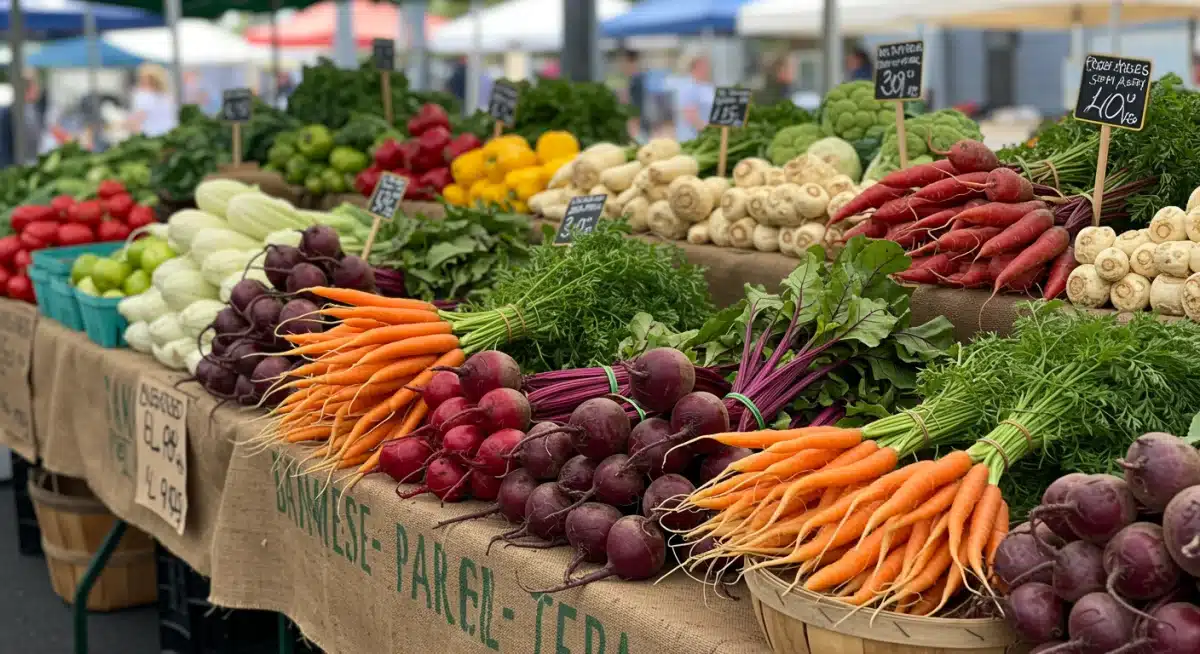
Planning for Future Fall Harvests
Embracing the fall 2025 harvest is not just about enjoying the current bounty; it’s also about laying the groundwork for future seasons. Strategic planning can help you extend the benefits of seasonal eating throughout the year and ensure you’re always prepared to make the most of what nature offers. This forward-thinking approach transforms seasonal consumption from a fleeting pleasure into a consistent lifestyle.
Consider techniques like freezing, canning, or dehydrating surplus vegetables. This allows you to preserve the peak freshness and nutritional value of your fall produce, making it available long after the season has passed. Imagine enjoying homemade pumpkin puree in January or roasted root vegetables in spring, all from your own preserved harvest. This not only provides year-round access to nutrient-dense foods but also reduces food waste and can save money.
Preservation Techniques
Explore these methods to make your fall harvest last:
- Freezing: Blanch vegetables like kale or Brussels sprouts before freezing to maintain color and texture.
- Canning: Ideal for squash, tomatoes, and some root vegetables, allowing for shelf-stable storage.
- Dehydrating: Great for making vegetable chips or adding to soups and stews later.
- Root Cellaring: For those with space, storing root vegetables in a cool, dark, humid environment can extend their freshness for months.
Learning and implementing these preservation techniques can empower you to take greater control over your food supply and enjoy the benefits of seasonal eating year-round. It’s a skill that connects us to ancestral practices and fosters a deeper appreciation for our food. Furthermore, it allows for greater food security and resilience, especially in times of fluctuating availability.
Beyond preservation, planning also involves thinking about your garden, if you have one, or even just your shopping habits for next year. What worked well this season? What would you like to try next? By reflecting on your experiences with the fall 2025 harvest, you can continuously refine your approach to seasonal eating, making it an even more rewarding and sustainable part of your life. This ongoing cycle of learning and adaptation ensures that each harvest is met with anticipation and preparedness.
| Key Aspect | Brief Description |
|---|---|
| Seasonal Peak | Fall 2025 vegetables offer peak flavor and nutritional density due to optimal growth conditions. |
| Nutrient Boost | Rich in vitamins A, C, K, fiber, and antioxidants essential for immune support and overall health. |
| Culinary Versatility | Wide range of cooking methods and innovative recipes to enjoy fall produce in every meal. |
| Sustainable Impact | Sourcing local produce reduces carbon footprint and supports regional farmers and economies. |
Frequently Asked Questions About Fall 2025 Harvest
During the Fall 2025 harvest, focus on squash varieties like butternut and acorn, root vegetables such as sweet potatoes and carrots, and leafy greens including kale and collard greens. These are at their peak freshness and nutritional value, offering robust flavors ideal for seasonal cooking.
To maximize nutrient retention, opt for cooking methods like steaming, roasting, or sautéing, which minimize nutrient loss compared to boiling. Incorporating raw vegetables into salads also preserves their full nutritional profile. Quick cooking times are generally best for most fall produce.
Seasonal eating provides vegetables at their nutritional peak and supports local agriculture, reducing transportation emissions. It promotes biodiversity, encourages a varied diet, and often means fresher, better-tasting produce. This practice connects consumers to their food sources and fosters sustainable habits.
Beyond traditional sides, try adding roasted root vegetables to grain bowls, blending squash into smoothies, or making hearty vegetable-based soups and stews. Experiment with different spices and herbs to enhance their natural flavors. One-pan meals with various fall vegetables are also excellent for convenience.
Preservation methods like freezing, canning, and dehydrating are excellent for extending the life of your fall harvest. Blanching and then freezing vegetables like kale or Brussels sprouts works well. Root vegetables can be stored in cool, dark places, and many squashes keep for months in a pantry.
Conclusion
The fall 2025 harvest offers a golden opportunity to enrich our diets and embrace a more sustainable way of eating. By focusing on seasonal vegetables, we not only gain access to peak nutrition and superior flavor but also support local economies and reduce our environmental footprint. From understanding the harvest cycle to creative cooking and smart preservation, every step taken towards incorporating these vibrant foods contributes to a healthier, more mindful lifestyle. Let this fall be a season of culinary exploration and profound nutritional benefit, setting a precedent for how we approach food in the years to come.
